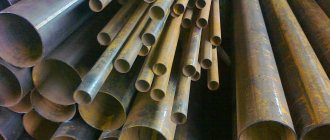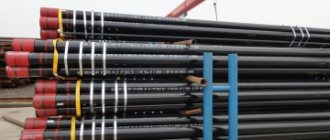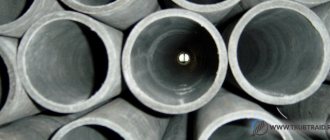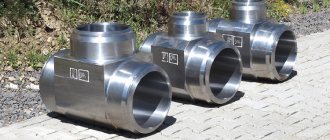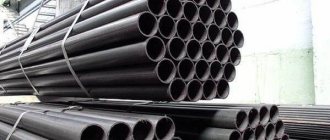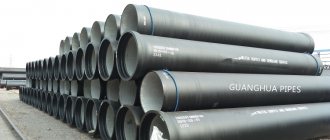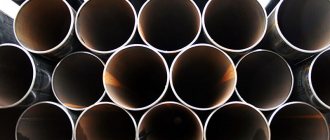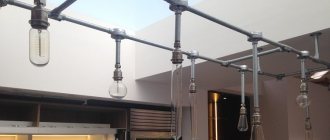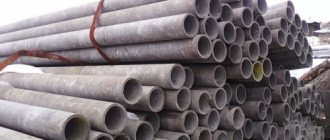This article is devoted to how to find out the diameter of a pipe that is already part of the gas and water supply system or is just about to be installed.
In this case, the choice of a specific measurement method is determined by the size, as well as the accessibility of the pipeline element.
You will need a tape measure to take measurements.
Ovality - pipe
The ovality of the pipes is checked by measuring the diameter in two mutually perpendicular directions.
The wall thickness is also checked by measuring it at four points. Ovality and thickness variations should be checked at both ends of the pipes. [1] Ovality of pipes at bending points is allowed no more than. [2]
The ovality of the pipes is determined by the tolerances on the outer diameter. [3]
The ovality of pipes with a diameter of 426 mm or more is 1% of the nominal outer diameter. [4]
Pipe ovality is defined as the difference between the maximum and minimum outer diameters, measured in one section of the sample with an error of no more than 0 1 mm using a caliper or an MK micrometer. [5]
The ovality of the pipes should not exceed 0 8 of the permissible deviations in the outer diameter. [6]
The ovality of pipes with a diameter of 426 mm or more in any section should not exceed 1% of the nominal outer diameter, the curvature of the pipes should not exceed 1 5 mm per 1 m of pipe length, and the total curvature should not exceed 0 2% of the pipe length. [8]
The ovality of the pipe at the point of its bend should not exceed 8% of its outer diameter; a decrease in ovality is achieved by bending the pipe 3–5 times more than it should, and then bending it back until the desired angle is obtained. [9]
The ovality of the pipe at the bend should not exceed 10% of its outer diameter; a decrease in ovality is achieved by bending the pipe 3 - 5 times more than normal, and then bending it back to obtain a given angle. [10]
The ovality of the pipes should not exceed the tolerance for the outer diameter. [eleven]
The ovality of the pipes is checked with a universal tool, but it is not too long. [12]
The ovality of pipes with a wall thickness of 0 02DH or less is established by agreement of the parties. [13]
The ovality of pipes rolled on rolls with Yu. M. Matveev’s calibration is somewhat less than when rolling on other calibrations, while in terms of pipe wall thickness this calibration has no advantages. [14]
Ovality of pipes as a type of defect usually occurs only in the absence of sizing and straightening mills. Ovality occurs when the roll caliber is incorrectly bored or when the height of the output chute of the mill is inaccurately set. [15]
Often when replacing pipes in a heating system, sewerage system or water supply, the question arises - how to determine the diameter at home without the help of a special tool. As a rule, measuring the diameter of pipes can be done using a regular construction tape and simple calculation formulas.
How is the diameter of a pipe measured if it is installed?
If the pipe is mounted and the end is not accessible for measurement, then a caliper is applied to the side surface at its widest point. This can only be done if the length of the legs exceeds half the diameter of the pipe.
If the diameter is quite significant, then measure the circumference with a tape measure or cord and divide the resulting value by the number π (approximately 3.14).
If the pipeline is for some reason inaccessible for measurements, then the pipe diameter is controlled by copying. To do this, a ruler or an object with known geometric dimensions (for example, boxes) is applied to the pipe and this area is photographed. Further, all measurements and calculations are carried out using photographs. To do this, determine the apparent thickness of the pipe in millimeters and convert the obtained data into real size, taking into account the scale of the survey.
Control of pipe dimensional parameters in production
All pipes supplied for construction or production must be provided with a certificate.
It states:
- nominal dimensions of products,
- regulatory documentation according to which they were manufactured,
- batch number,
- brand of material,
- results of tests and other necessary information.
Markings must be applied to the end of the pipe at a distance of 500 mm from the end. The markings indicate: the name of the manufacturing company, the heat number, the nominal dimensions of the product, the pipe number and the date of its manufacture.
Before using communications on construction sites and in production, they are necessarily subjected to input control with the measurement of their geometric parameters. The length is measured with a tape measure or wire.
The permissible deviation of the length from the declared value for pipes of the first class can be no more than 15 mm in the direction of increase or decrease, for products of the second class - no more than 100 mm.
The outer diameter of pipe products in production is calculated using a slightly complicated formula. The circumference of the pipe is divided by the number π, and from the result obtained, the double thickness of the measuring tape and 0.2 mm - the fit tolerance - are subtracted.
Permissible deviations of the outer diameter from the declared one for pipes with a diameter of less than 200 mm are equal to 1.5 mm. To measure large diameter products, an ultrasonic pipe measuring unit is used .
Measuring a large product with or without a tape measure, ruler, caliper
- LiveJournal
- Blogger
Measuring a large product will require careful calculations.
It is not difficult to measure a pipe with significant dimensions. To do this, determine the circumference using a tape measure or cord and find the diameter of the workpiece using the formula D = L/Pi. The first value is the diameter of the pipe, the second is the circumference. For example, the circumference is 35.2 cm, then D is equal to 11.2 centimeters or 112 mm (35.2: 3.14). What to do if an element is completely unavailable
No access to pipes found? Measurements are carried out using the copying method. A small object with known dimensions is placed on the surface of the product and photographed. Calculations are made from the resulting photograph. The visible thickness of the element is determined to the nearest millimeter. Calculations are converted to real size, referring to the shooting scale. The diameter of the pipes must be measured with great accuracy, since many functions of pipeline communications depend on this indicator.
How to determine the diameter at home
You will need the following tools and devices:
- any measuring ruler or tape measure;
- calipers;
- If necessary, a camera.
If it is fully available for measurement
Determining the outer diameter with a caliper
If you need to measure the diameter of pipes, the ends of which are accessible for direct observation and measurement, and provided that the requirements for calculation accuracy are minimal, use a construction tape or ruler.
- Attach your measuring tool to the end of the product, at the level of its widest part.
- Next, count the number of divisions that will correspond to the diameter.
- This method makes it possible to find out the dimensions of products with an accuracy of up to several millimeters.
To measure the outside diameter of small pipes, you can use a caliper.
- Spread the legs of the tool and attach them to the end of the product.
- Then slide them so that they are pressed fairly tightly against the outer walls of the water pipe.
- Use the instrument's scale to determine the outer diameter. The accuracy of this method is down to tenths of a millimeter.
If the pipe is already installed
When the end part of the product is not accessible for measurement, for example, if it is an element of an existing gas or water supply system, this must be done.
- A caliper is applied for measurements to the side surface of the water pipe.
- Using this method, you can measure a pipe when the length of the tool legs exceeds half its diameter.
How to measure a large item
Measuring the circumference of a pipe
Next, how the diameter of the pipe is measured if it is large enough.
This is very easy to do, knowing the length of its circumference and the number π, approximately equal to 3.14.
- First, use a tape measure or cord to measure the pipe around its circumference to determine the circumference.
- Next, substitute the values you know into a simple formula: d=l:π, where the symbols mean: d is the diameter you are looking for, l is the found circumference.
For example: l is 31.4 cm. In this case, d=31.4:3.14. We get 10 cm, which corresponds to 100 mm.
How to measure the diameter of a pipe that is completely accessible for measurement?
If it is necessary to measure the diameter with minimal requirements for accuracy, and the cross-section of the product is completely accessible for measurements, then you can use a regular ruler or tape measure. The measuring instrument is applied at the widest part and the number of divisions is counted. This method allows you to determine the outer diameter with an accuracy of a few millimeters.
To measure small diameter products, use a caliper. To do this, the legs of the tool are applied to the end and pressed firmly, but without force, against the outer walls of the pipe. Using the instrument scale, the diameter is determined with an accuracy of tenths of a millimeter.
To calculate the internal diameter, the thickness of the pipe walls is measured along the cut. Double the wall thickness is subtracted from the outer diameter to obtain the inner diameter.
Steel water pipes are defined by their internal diameter, which is often measured in inches. How to find out the diameter of a pipe in inches if this value is known in centimeters?
To do this, you need to multiply the diameter in centimeters by 0.398. To convert back, the diameter in inches is multiplied by 2.54. That is, the internal diameter of a one-inch pipe is equal to 2.54 cm or 25.4 mm, and, for example, a ½-inch diameter is approximately 12.7 mm.
Control of pipe diameter and other parameters under production conditions
Before starting installation work on large construction sites, pipes must undergo incoming inspection.
Checking certificates and product labeling
Product certificates must contain:
- their nominal sizes;
- number and date of technical specifications;
- grade of steel or plastic;
- batch number;
- results of mechanical and hydraulic tests;
- results of X-ray flaw detection;
- type of heat treatment;
- chemical analysis of smelting.
The following markings must be applied to the surface of each pipe, 50 cm from one of the ends of the product:
- its manufacturing plant;
- heat and contract numbers;
- nominal dimensions and pipe number;
- date of its production;
- carbon equivalent.
Overall dimensions of pipes
- The length of products in production is measured using a measuring wire or tape measure . In this case, permissible deviations in the declared length of pipes of the first accuracy class: 15 mm up or down. For second class pipes this figure is 100 mm.
- The outer diameter of pipes for water supply or sewerage is checked using a slightly complicated formula, which was given above: d = l:π-2Δр-0.2 mm . In it, in addition to the components that you already know: Δр is the thickness of the measuring tape, in mm, and 0.2 mm is the allowance that is given for its fit to the pipe.
The maximum permissible deviations of the outer diameter from the declared one are for products with a cross-section of less than 200 mm - 1.5 mm up or down.
For large pipes, deviations are measured as a percentage, for example for products 820/1020mm - this is 0.7%. For this purpose, a pipe measuring unit of the ultrasonic type is used.
- The wall thickness is measured in production using calipers, each scale division of which is equal to 0.01 mm. In this case, the minus tolerance should be no more than 5% of the nominal pipe thickness.
Acceptable defectiveness of products
The curvature of the pipe should not be more than 1.5 mm per 1 m of its length. The total curvature of the product should not be more than 0.15% of its length.
The ovality of the pipe ends is the ratio of the difference between their largest and smallest diameters to the nominal diameter. This parameter should be no more than 1% for pipe wall thicknesses less than 20 mm and 0.8% for walls more than 20 mm.
How to measure pipe ovality. It is determined by measuring the diameter of the end part of the product with an indicator bracket or bore gauge in two planes that are mutually perpendicular .
As you can see, all the necessary actions described in this article are simple and can be carried out by any of you.
